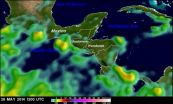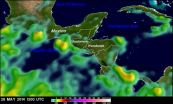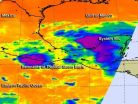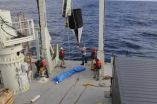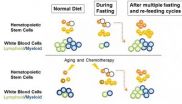(Press-News.org) VIDEO:
TRMM satellite data showed that some areas in southwestern Mexico received over 12 inches of rainfall (red) from Boris, while System 90L on the eastern side of Mexico brought similar...
Click here for more information.
The remnants of former Tropical Storm Boris moved over southern Mexico and NASA and NOAA satellite data showed that they were merging with a low pressure area in the southwestern Gulf of Mexico. In addition, data from NASA's TRMM satellite was used to compile rainfall totals from Boris' slow trek over southern Mexico.
A visible image taken from NOAA's GOES-East satellite on June 5 at 10:45 a.m. EDT showed the clouds associated with developing System 90L in the Bay of Campeche merging with the remnants of former Tropical Storm Boris.
When NASA's Aqua satellite passed over the remnants of Tropical Storm Boris on June 5 at 08:05 UTC (4:05 a.m. EDT), they were merging with System 90L, the elongated low pressure area in the southwestern Gulf of Mexico. The Atmospheric Infrared Sounder (AIRS) instrument aboard Aqua provided temperature data on the clouds associated with both Boris' remnants and System 90L Both low pressure areas showed high clouds with temperatures near -63F (-52C). Cloud top temperatures that cold indicate thunderstorms strong enough with the potential to drop heavy rainfall, and the National Hurricane Center warned about flash flooding and mudslides in southern and southeastern Mexico.
The National Hurricane Center issued the final bulletin on the remnants of Boris on June 4 at 2100 UTC (5 p.m. EDT). At that time, the center of the remnant low pressure area was near 16.5 north latitude and 94.0 west longitude, about 80 miles east of Salina Cruz, Mexico. As has been the case with Boris for days, its remnants continued to move slowly and were only tracking north at 1 knot (1.1 mph/1.8 kph) per hour. Maximum sustained winds 20 knots (23 mph/37 kph).
At that time Boris no longer qualified as a tropical cyclone and it was merging with System 90L located in the Bay of Campeche.
On Thursday, June 5, System 90L appeared to be coming together with the remnant moisture from Boris. Forecasters have been watching System 90L most of the past week, and until Boris made its way across southern Mexico, the system had a low chance for development. Now System 90L has a medium chance for becoming a tropical depression, according to the National Hurricane Center (NHC).
System 90L was centered near 19.3 north and 94.3 west, in the Bay of Campeche. The Bay of Campeche is part of the southwestern Gulf of Mexico and is surrounded on three sides by the Mexican states of Veracruz, Campeche, and Tabasco.
At 8 a.m. EDT, NHC noted that System 90L's showers and thunderstorms had increased and that despite strong upper-level winds, some further development of this system is possible over the next day or two if the low remains offshore of eastern Mexico.
Mexico's National Meteorological Service cautioned today, June 5, that heavy rainfall is possible in the states of the Yucatan Peninsula, southeastern and eastern Mexico. For updated forecasts in Spanish, visit: http://smn.cna.gob.mx.
At NASA's Goddard Space Flight Center in Greenbelt, Maryland, data from the Tropical Rainfall Measuring Mission (TRMM) satellite data was used to compile totals of the already soaking rains from Boris. The TRMM data showed that some areas in southwestern Mexico received over 12 inches of rainfall from Boris, while System 90L on the eastern side of Mexico brought similar totals to parts of the Yucatan.
Boris may be gone now, but System 90L has the potential to produce extremely heavy rains and life-threatening flash floods and mud slides over portions of southeastern Mexico during the next few days.
INFORMATION:
NASA sees remnants of Tropical Storm Boris merging with Gulf low
2014-06-05
ELSE PRESS RELEASES FROM THIS DATE:
New therapy for pancreatic cancer patients shows promising results
2014-06-05
SCOTTSDALE, Ariz. — June 5, 2014 — A clinical trial conducted by researchers at the Virginia G. Piper Cancer Center Clinical Trials, a partnership between Scottsdale Healthcare and the Translational Genomics Research Institute (TGen), showed that a new drug called MM-398, given in combination with 5-flourouracil (5FU) and leucovorin, produced a significant overall survival rate in patients with advanced, previously-treated pancreatic cancer.
The NAPOLI-1 (NAnoliPOsomaL Irinotecan) Phase 3 study — a final confirmation of a drug's safety and effectiveness — was conducted ...
Team finds on-off switch to burning stored fat
2014-06-05
SAN ANTONIO, Texas (June 5, 2014) — Scientists this week reported that a molecular pathway called mTORC1 controls the conversion of unhealthy white fat into beige fat, an appealing target for increasing energy expenditure and reducing obesity. The team, led by researchers from the School of Medicine at The University of Texas Health Science Center at San Antonio, also found that a protein, Grb10, serves as the on-off switch for mTORC1 signaling and the "beigeing" of fat.
The finding could inform development of novel diabetes and obesity drugs, the scientists said. The ...
How do phytoplankton survive a scarcity of a critical nutrient?
2014-06-05
Phytoplankton—tiny, photosynthetic organisms—are essential to life on Earth, supplying us with roughly half the oxygen we breathe. Like all other life forms, phytoplankton require the element phosphorus to carry out critical cellular activity, but in some parts of the world's ocean, P is in limited supply. How do phytoplankton survive when phosphorus is difficult to find?
Phytoplankton can alter their biochemical make-up according to the availability of nutrients in the water. When phosphorus (P) is particularly abundant in the water, phytoplankton produce and store ...
Stimulating a protein in skin cells could improve psoriasis symptoms
2014-06-05
Psoriasis is a common, long-lasting disease that causes itchy or sore patches of thick, red skin with silvery scales. Environmental contaminants can trigger psoriasis and other autoimmune disorders, and it is thought that a protein called the aryl hydrocarbon receptor (AhR), which senses environmental toxins, could play a role. A study published by Cell Press on June 5 in the journal Immunity shows that the severity of inflammation associated with psoriasis is unexpectedly suppressed by AhR. The findings suggest that stimulation of AhR could improve symptoms and may represent ...
Neurons transplanted into Parkinson's-affected brains appear healthy after 14 years
2014-06-05
When transplanted into the midbrains of adult patients with Parkinson's disease, dopamine neurons derived from fetal tissue can remain healthy for many years. The findings reported in the Cell Press journal Cell Reports on June 5th suggest that transplanted neurons don't degenerate over time as some had suggested and feared they would, which provides further rationale for pursuing stem cells as a source for transplant-ready dopamine neurons, according to the researchers.
"Our findings show a robust expression of dopamine transporters and a lack of abnormal mitochondrial ...
Activating the immune system could treat obesity and diabetes
2014-06-05
Obesity is a worldwide epidemic that is causing alarming rates of diabetes and cardiovascular disease, but currently there is a lack of effective drug treatments. Two unrelated studies published by Cell Press June 5th in the journal Cell reveal an important role for immune pathways in activating good types body fat, called brown and beige fat, which burn stored calories, reduce weight, and improve metabolic health. The findings could pave the way for much-needed treatments for obesity and related metabolic diseases.
"The idea that metabolic health can be improved by activation ...
Fasting may help protect against immune-related effects of chemotherapy and aging
2014-06-05
While chemotherapy can save lives, it can also cause many side effects, including the depletion of immune cells. Also, even in the absence of chemotherapy, normal aging takes a heavy toll on the immune system, leading to immune deficiencies and a higher risk of developing leukemia and a variety of malignancies with age. Now researchers reporting in the June 5th issue of the Cell Press journal Cell Stem Cell have found that a simple dietary intervention—periodic fasting—may combat both chemotherapy-induced and aging-related changes in immune cell function by replenishing ...
Outcomes of a 2-year national rare disease gene discovery project
2014-06-05
OTTAWA, ON – June 5, 2014 – As part of the Finding of Rare Disease Genes (FORGE) research project, Canadian researchers have developed an expertise in understanding the underlying biology of rare childhood disorders. The first public commentary of this nationwide study is available today in the American Journal of Human Genetics.
"When we launched this project, we predicted we might explain, or solve, 50 disorders; we've almost tripled that goal," said Dr. Kym Boycott, lead investigator of FORGE and clinician scientist at the Children's Hospital of Eastern Ontario ...
First 3-D pterosaur eggs found with their parents
2014-06-05
Researchers have discovered the first three-dimensionally preserved pterosaur eggs in China. The eggs were found among dozens, if not hundreds, of pterosaur fossils, representing a new genus and species (Hamipterus tianshanensis). The discovery, described in the Cell Press journal Current Biology on June 5, reveals that the pterosaurs—flying reptiles with wingspans ranging from 25 cm to 12 m—lived together in gregarious colonies.
Xiaolin Wang of the Chinese Academy of Sciences' Institute of Vertebrate Paleontology and Paleoanthropology says it was most exciting to find ...
McLean Hospital researchers see promise in transplanted fetal stem cells for Parkinson's
2014-06-05
BELMONT, MA -- Researchers at Harvard-affiliated McLean Hospital have found that fetal dopamine cells transplanted into the brains of patients with Parkinson's disease were able to remain healthy and functional for up to 14 years, a finding that could lead to new and better therapies for the illness.
The discovery, reported in the June 5, 2014 issue of the journal Cell Reports, could pave the way for researchers to begin transplanting dopamine neurons taken from stem cells grown in laboratories, a way to get treatments to many more patients in an easier fashion.
"We ...
